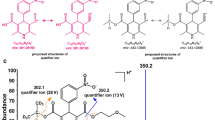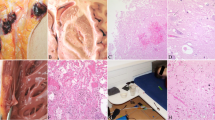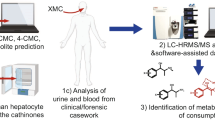Abstract
Purpose
This study aimed to validate a modified QuEChERS method followed by ultra-high performance liquid chromatography–tandem mass spectrometry to determine 79 new psychoactive substances (NPS) and other drugs in blood and urine.
Methods
Prescription drugs (n = 23), synthetic cathinones (n = 13), phenethylamines (n = 11); synthetic cannabinoids (n = 8), amphetamines (n = 7) and other psychoactive substances (n = 17) were included in the method. 500 µL of biological fluid was extracted with 2 mL of water/ACN (1:1), 500 mg of anhydrous MgSO4/NaOAc (4:1) added, followed by a supernatant cleanup with 25 mg of primary secondary amine and 75 mg of anhydrous MgSO4. Quantification was done using matrix-matched calibration curves and deuterated internal standards.
Results
The method was satisfactorily validated for blood and urine at limit of quantifications ranging from 0.4 to 16 ng/mL, and applied to the analysis of 54 blood (38 postmortem and 16 antemortem) and 16 antemortem urine samples from 68 forensic cases. All urine samples and 59.3% of the blood samples were positive for at least one analyte. Twenty-two analytes were detected in at least one biological sample, including the synthetic cathinones ethylone (222 ng/mL, antemortem blood), eutylone (246 and 446 ng/mL, urine), and N-ethylpentylone (597 and 7.3 ng/mL, postmortem and antemortem blood, respectively).
Conclusions
The validated method was shown to be suitable for the analysis of blood and urine forensic samples and an important tool to collect information on emerging drug threats and understanding the impact of NPS and other drugs in poisoning cases.




Similar content being viewed by others
References
UNODC (2020) World drug report 2020. https://wdr.unodc.org/wdr2020/field/WDR20_BOOKLET_4.pdf. Accessed 25 Apr 2021
UNODC (2019) Early warning advisory on new psychoactive substances 2019. https://www.unodc.org/LSS/Page/NPS. Accessed 25 Apr 2021
EMCDDA (2020) European drug report 2020. https://www.emcdda.europa.eu/publications/edr/trends-developments/2020_en. Accessed 25 Apr 2021
de Souza BB, Silveira Filho J, Nonemacher K et al (2020) New psychoactive substances (NPS) prevalence over LSD in blotter seized in State of Santa Catarina, Brazil: a six-year retrospective study. Forensic Sci Int 306:110002. https://doi.org/10.1016/j.forsciint.2019.110002
Machado Y, Coelho Neto J, Lordeiro RA et al (2019) Profile of new psychoactive substances (NPS) and other synthetic drugs in seized materials analysed in a Brazilian forensic laboratory. Forensic Toxicol 37:265–271. https://doi.org/10.1007/s11419-018-0456-3
Costa JL, Cunha KF, Lanaro R et al (2019) Analytical quantification, intoxication case series, and pharmacological mechanism of action for N-ethylnorpentylone (N-ethylpentylone or ephylone). Drug Test Anal 11:461–471. https://doi.org/10.1002/dta.2502
Ferrari Júnior E, Caldas ED (2018) Simultaneous determination of drugs and pesticides in postmortem blood using dispersive solid-phase extraction and large volume injection-programmed temperature vaporization-gas chromatography–mass spectrometry. Forensic Sci Int 290:318–326. https://doi.org/10.1016/j.forsciint.2018.07.031
Ferrari Júnior E, dos Santos JBA, Caldas ED (2021) Drugs, pesticides and metabolites in forensic post-mortem blood samples. Med Sci Law 61:97–104. https://doi.org/10.1177/0025802420965006
Kraemer M, Boehmer A, Madea B, Maas A (2019) Death cases involving certain new psychoactive substances: a review of the literature. Forensic Sci Int 298:186–267. https://doi.org/10.1016/j.forsciint.2019.02.021
Elliott SP, Stephen DWS, Paterson S (2018) The United Kingdom and Ireland association of forensic toxicologists forensic toxicology laboratory guidelines (2018). Sci Justice 58:335–345. https://doi.org/10.1016/j.scijus.2018.05.004
Helander A, Bäckberg M, Hultén P et al (2014) Detection of new psychoactive substance use among emergency room patients: results from the Swedish STRIDA project. Forensic Sci Int 243:23–29. https://doi.org/10.1016/j.forsciint.2014.02.022
Peters FT (2014) Recent developments in urinalysis of metabolites of new psychoactive substances using LC-MS. Bioanalysis 6:2083–2107. https://doi.org/10.4155/bio.14.168
Montenarh D, Hopf M, Warth S et al (2015) A simple extraction and LC-MS/MS approach for the screening and identification of over 100 analytes in eight different matrices. Drug Test Anal 7:214–240. https://doi.org/10.1002/dta.1657
Lau T, Concheiro M, Cooper G (2020) Determination of 30 synthetic cathinones in postmortem blood using LC–MS-MS. J Anal Toxicol 44:679–687. https://doi.org/10.1093/jat/bkaa071
Lehmann S, Kieliba T, Beike J et al (2017) Determination of 74 new psychoactive substances in serum using automated in-line solid-phase extraction-liquid chromatography-tandem mass spectrometry. J Chromatogr B 1064:124–138. https://doi.org/10.1016/j.jchromb.2017.09.003
Anzillotti L, Odoardi S, Strano-Rossi S (2014) Cleaning up blood samples using a modified “QuEChERS” procedure for the determination of drugs of abuse and benzodiazepines by UPLC–MSMS. Forensic Sci Int 243:99–106. https://doi.org/10.1016/j.forsciint.2014.05.005
Dulaurent S, El Balkhi S, Poncelet L et al (2016) QuEChERS sample preparation prior to LC-MS/MS determination of opiates, amphetamines, and cocaine metabolites in whole blood. Anal Bioanal Chem 408:1–8. https://doi.org/10.1007/s00216-015-9248-3
Orfanidis A, Gika H, Theodoridis G et al (2020) A UHPLC–MS-MS method for the determination of 84 drugs of abuse and pharmaceuticals in blood. J Anal Toxicol 45:28–43. https://doi.org/10.1093/jat/bkaa032
Colaço CS, Alves SS, Nolli LM et al (2020) Toxicity of ayahuasca after 28 days daily exposure and effects on monoamines and brain-derived neurotrophic factor (BDNF) in brain of Wistar rats. Metab Brain Dis 35:739–751. https://doi.org/10.1007/s11011-020-00547-w
AAFS (2019) Standard practices for method validation in forensic toxicology, American Academy of Forensic Sciences. http://www.asbstandardsboard.org/wp-content/uploads/2019/11/036_Std_e1.pdf. Accessed 20 Mar 2021
McDonald JH (2014) Handbook of biological statistics, 3rd edn. Sparky House Publishing, Baltimore
Van Eeckhaut A, Lanckmans K, Sarre S et al (2009) Validation of bioanalytical LC–MS/MS assays: evaluation of matrix effects. J Chromatogr B 877:2198–2207. https://doi.org/10.1016/j.jchromb.2009.01.003
Odoardi S, Fisichella M, Romolo FS, Strano-Rossi S (2015) High-throughput screening for new psychoactive substances (NPS) in whole blood by DLLME extraction and UHPLC–MS/MS analysis. J Chromatogr B 1000:57–68. https://doi.org/10.1016/j.jchromb.2015.07.007
Yang CA, Liu HC, Lin DL et al (2017) Simultaneous quantitation of methamphetamine, ketamine, opiates and their metabolites in urine by SPE and LC–MS-MS. J Anal Toxicol 41:679–687. https://doi.org/10.1093/jat/bkx057
Gaunitz F, Kieliba T, Thevis M, Mercer-Chalmers-Bender K (2020) Solid-phase extraction–liquid chromatography–tandem mass spectrometry method for the qualitative analysis of 61 synthetic cannabinoid metabolites in urine. Drug Test Anal 12:27–40. https://doi.org/10.1002/dta.2680
Schulz M, Schmoldt A, Andresen-Streichert H, Iwersen-Bergmann S (2020) Revisited: therapeutic and toxic blood concentrations of more than 1100 drugs and other xenobiotics. Crit Care 24:1–4. https://doi.org/10.1186/s13054-020-02915-5
Zawilska JB, Kacela M, Adamowicz P (2020) NBOMes–highly potent and toxic alternatives of LSD. Front Neurosci 14:78. https://doi.org/10.3389/fnins.2020.00078
Halberstadt AL (2017) Pharmacology and toxicology of N-benzylphenethylamine (“NBOMe”) hallucinogens. Curr Top Behav Neurosci 32:283–311. https://doi.org/10.1007/7854_2016_64
Arantes LC, Júnior EF, de Souza LF et al (2017) 25I-NBOH: a new potent serotonin 5-HT2A receptor agonist identified in blotter paper seizures in Brazil. Forensic Toxicol 35:408–414. https://doi.org/10.1007/s11419-017-0357-x
Nielsen LM, Holm NB, Leth-Petersen S et al (2017) Characterization of the hepatic cytochrome P450 enzymes involved in the metabolism of 25I-NBOMe and 25I-NBOH. Drug Test Anal 9:671–679. https://doi.org/10.1002/dta.2031
Shintani-Ishida K, Saka K, Nakamura M et al (2018) Experimental study on the postmortem redistribution of the substituted phenethylamine, 25B-NBOMe. J Forensic Sci 63:588–591. https://doi.org/10.1111/1556-4029.13583
Lee D, Chronister CW, Hoyer J, Goldberger BA (2015) Ethylone-related deaths: toxicological findings. J Anal Toxicol 39:567–571. https://doi.org/10.1093/jat/bkv053
Patel BN, Sharma N, Sanyal M, Shrivastav PS (2008) High throughput and sensitive determination of trazodone and its primary metabolite, m-chlorophenylpiperazine, in human plasma by liquid chromatography–tandem mass spectrometry. J Chromatogr B 871:44–54. https://doi.org/10.1016/j.jchromb.2008.06.046
Gaillard YP, Cuquel AC, Boucher A et al (2013) A fatality following ingestion of the designer drug meta-chlorophenylpiperazine (mCPP) in an asthmatic—HPLC-MS/MS detection in biofluids and hair. J Forensic Sci 58:263–269. https://doi.org/10.1111/j.1556-4029.2012.02254.x
Atherton D, Dye D, Robinson CA, Beck R (2019) n-Ethyl pentylone-related deaths in Alabama. J Forensic Sci 64:304–308. https://doi.org/10.1111/1556-4029.13823
Krotulski AJ, Papsun DM, De Martinis BS et al (2018) N-Ethyl pentylone (ephylone) intoxications: quantitative confirmation and metabolite identification in authentic human biological specimens. J Anal Toxicol 42:467–475. https://doi.org/10.1093/jat/bky025
Krotulski AJ, Papsun DM, Chronister CW et al (2020) Eutylone intoxications—an emerging synthetic stimulant in forensic investigations. J Anal Toxicol 45:8–20. https://doi.org/10.1093/jat/bkaa113
Acknowledgements
The authors thank Tales Mateus Vieira da Rocha for the help with sample preparation.
Author information
Authors and Affiliations
Corresponding author
Ethics declarations
Conflict of interest
There are no financial or other relations that could lead to a conflict of interest to disclose.
Ethical approval
This study was approved by the Ethical Committee for Human Studies of the University of Brasilia, Brazil (CAAE 2936819.3.0000.0030).
Additional information
Publisher's Note
Springer Nature remains neutral with regard to jurisdictional claims in published maps and institutional affiliations.
Supplementary Information
Below is the link to the electronic supplementary material.
Rights and permissions
About this article
Cite this article
Ferrari Júnior, E., Caldas, E.D. Determination of new psychoactive substances and other drugs in postmortem blood and urine by UHPLC–MS/MS: method validation and analysis of forensic samples. Forensic Toxicol 40, 88–101 (2022). https://doi.org/10.1007/s11419-021-00600-y
Received:
Accepted:
Published:
Issue Date:
DOI: https://doi.org/10.1007/s11419-021-00600-y




